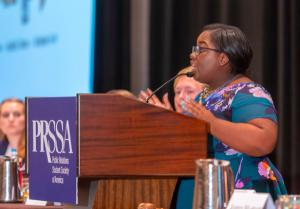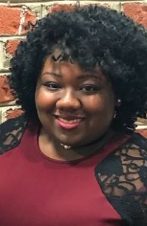A Seat at the Table and a Chance to Speak

As an aspiring Communications professional and a woman of color, I have undoubtedly had a different experience trying to break into the public relations industry. I personally understand the importance of fair representation and strive to be a part of the continued effort to diversify the industry through acts of inclusion. It is especially important to have diversity on all employment levels. This is where true inclusion takes place, as diversity at the board level brings many competing perspectives into account.
When employees represent varied backgrounds, companies can be more adaptable to ever changing environments in this fast-changing world. So many companies unknowingly make the mistake of starting diversity initiatives for the sake of meeting a quota, however, what is really important is implement inclusion efforts. In order to be inclusive, we must truly understand what inclusion entails and look at diversity and inclusive as two distinct things.
To move from a place of merely hiring people from diverse backgrounds to a true place of inclusivity, it is necessary to understand the difference between the two. Simply put, diversity is a means of identifying our differences in terms of varied backgrounds and experiences, where inclusion is cherishing, appreciating and working to make those differences an integral part of the way we do business. In understanding the importance of having people from multiple backgrounds with varied experiences, companies must begin to give a voice to these individuals. Diversity and inclusion consultant Verna Myers, states that diversity is being invited to the party; inclusion is being asked to dance. She goes on to share that it is not enough to want diversity. Organizations need to welcome and embrace diverse perspectives in order to maintain diversity and implement inclusivity.
According to Andrew McCaskill, APR, senior vice president of global communications at Nielsen, “The only people who…really understand how big the diversity problem is in PR are the people of color.” He continues in saying, “The US consumer market is changing. Multicultural Americans are not only driving culture, but we’re driving markets. If your teams don’t reflect or understand your customer base, it’s not just bad optics; it’s strategy malpractice. There are too many senior level black folks on the corporate side of the business for that to be true”. It is astounding to think that the individuals who see the issues surrounding diversity are the very ones affected by it. Diverse individuals should not be the ones promoting and fighting for the diversification of this industry. As practitioners, there must be an effort toward understanding the importance and benefits of diverse voices. Rather than celebrating diversity, we must begin to value the ideal to a point of making this a normal and central part of our establishments. Celebrations come rare and few based on special occasions but if diversity and inclusion become defining, foundational points for our corporations, there will not be anything to celebrate. We as an industry must work to not only make it easier for people of color to leave their mark but to feel comfortable in doing so. We must move away from this traditionalist approach and embrace change. With a new face comes new and innovative ideas, along with a new fate of the industry and this is something establishments must not only be okay with but guide their businesses by. Hiring a few people of color will not cut it. We cannot just embrace the ideas of diverse individuals without crediting these individuals for their contributions and providing them with the platform to receive such recognition.”
I can attest to the rarity of seeing individuals in higher positions of which I could easily identify with. I am able to look to the accomplishments of profound women of color in this field such as Rochelle Ford, Ph.D., APR, Brandi Boatner, Lori George Billingsley or Cheryl I. Procter-Rogers, APR, Fellow PSA to name a few. Although these are prime examples of women of color working to break barriers and innovate our industry, this is far less than it should be. It is important for younger generations to see themselves represented because this instills a sense of confidence of what they can achieve.
Many companies fail to realize this lack of diversity and inclusivity does not just impact businesses now, rather it will determine the way we do business in the future. If students of color like myself do not have many examples to look up to, they will not feel comfortable nor see a reason to enter this industry. This too is much more than internal efforts of diversity and inclusion, rather external. Tom Burrell, of Burrell Communications Group, began pioneering what is now known as targeted advertising, by producing advertisements and public relations strategies that were aimed specifically at black people and that incorporated elements of black culture.
He shares the sentiment, “I had to convince clients to understand that black people are not dark-skinned white people. Sometimes when you start talking to people about race and differences, implied in that is some kind of subordination, so I had to convince them that you can be different and equal and that there are cultural differences that should be part of advertising aimed at a black cultural group, such as music”. Burrell became famous for this signature phrase and managed to transform the industry with this simple motto. As the 2018 Betsy Plank Honoree by The Plank Center for Leadership in Public Relations, Tom Burrell sets a prime example of how to impactfully target black consumers and stakeholders; however, in order to do this, it is imperative to have diverse people in your boardrooms. Diversity and inclusion truly come full circle as a lack of diversity may limit the vast ideas that can be used to better business, furthermore, it also limits the potential reach you will have with diverse consumer groups.
For these and many other reasons, I became very heavily involved in PRSSA, and my life has been forever changed. For me, it was important to break a major barrier and go for something I typically would not. As the 2017−2018 President of the Millersville University Chapter, I stood as the only diverse person the organization at the time. Though I attend an institution lacking much diversity, this is still eye-opening for me. This triggered a need to contribute in a greater way.
This is when I knew I had to put fear to the side and instead and when I decided to run for the PRSSA National Committee. I am now blessed to serve as the national vice president of digital communications. It was upon my appointment that I realized this is so much greater than me. Several students have approached me thanking me and exclaiming how much of an impact I made. For months, I could not understand what I did that merited such strong gratitude. It is hard to see myself as the leader that diverse students see me as; however, it is an honor to help in bridging the gap. Many have even expressed interest in running for the National Committee next year. I strongly believe this to be a result of seeing someone they could easily identify with and in turn, feeling comfortable enough to believe they too, are capable because someone like them is doing it now. The example I am setting for the students of color of PRSSA is the same example these students need to see at the professional level. I am grateful to serve as a driving force to encourage other students who look like me in the way diverse women in this field have done for me. Now is the time, however, to expand what this looks like.
This is much more than an organizational issue, rather a systemic issue to be addressed. The issues surrounding diversity and inclusion cannot be resolved overnight but the change starts with each of us. By making diverse people feel a sense of belonging, they will feel they have an ally and advocate in you. It is so important to take this to a company approach and think just how much more impactful your organization will be if you can reach all people. This is the most diverse our industry has been and through dedicated service toward the goal of having fair representation across the board, we can only become more diverse of an industry. It all starts with you making the conscious decision to take a stand against the lack of diversity in your organization and begin efforts of including diverse people in positions that matter.
–
Briana Spears, 2018–2019 vice president of digital communications, is a senior at Millersville University of Pennsylvania majoring in speech communications with a concentration in public relations.

